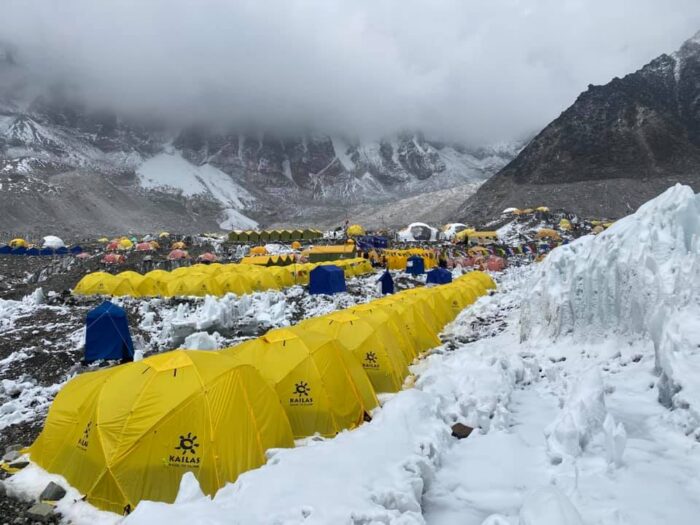Individual tents with furniture and ensuite bathrooms, huge lounge domes, bakeries, and massage parlors, all thriving on the Khumbu Glacier while helicopters going up and down constantly…
Welcome to Everest Base Camp. Or at least an exclusive corner of it.
A frantic race is on to offer all kinds of luxuries to premium clients. Now, the Sherpa mayors of the Khumbu Valley are trying to curb the growth of Base Camp infrastructures with new rules. The idea is to ease the environmental impact of expeditions, as well as try to preserve local culture, lifestyle, and economy.
As we mentioned earlier this week, the obligation for climbers to carry wag bags and bring down their excrement from the mountain is just one of a new set of regulations established by the Khumbu-Pasang Lhamu village municipality. Their jurisdiction includes most base camps in the region, including Everest’s.
Yesterday, they made public a document entitled Base Camp Management Procedure 2024. While some technical issues need fine-tuning, the basis of the document has been approved for the upcoming spring season. Some of these measures may be a pain for the biggest outfitters.
Stop the extravagance

Everest Base Camp. Photo: 14 Peaks Expedition
The Khumbu authorities have coordinated with the Sagarmatha Pollution Control Committee (SPCC), Nepal’s Department of Tourism, and the Army. But theirs are not the only new regulations in the making. A new tourism bill will be tabled in Parliament soon, Dawa Steven Sherpa told ExplorersWeb.
The expedition leader of Asian Trekking and climate activist has advised on both projects. Dawa Steven is also secretary of the Expedition Operators Association, and a Khumbu Sherpa himself. “I share the local’s concern for the future of the Everest region,” he said. “The Khumbu region leaders are trying to reign in the extravagance at Base Camps,” he explained.
We asked him about some of the regulations that may specifically affect commercial expeditions.
Goodbye to the big domes
One of the main changes limits the size of tents, especially the huge dining tents. Toilets attached to individual tents will disappear, the number of tents per camp will be reduced, and the use of flashing lights will cease.
The document, though well-meaning, is not perfect. One problem is that the original document establishes 10 sq ft (less than 1 sq meter) per person in the dining tent.
“This is an error and not practical,” Dawa Steven said, “as it barely accommodates one chair. 50 sq ft (4.6 sq. m) would be adequate, taking into account seating, table, walkway, and serving space.”
Still, the huge domes that dominate every team’s Base Camp, with their comfy armchairs, spacious tables, jumbo screens, and great views of the mountains will hardly meet the new requirements. Yet clients coming this season are expecting them, and have already paid for them. In fact, some of the high-end expeditions offer luxury dome tents for individuals, elaborately furnished.

Executive Dome tents for upscale clients with Climbing the Seven Summits.
Visitors not welcome?
Another controversial part of the new regs defines “tourists” as those neither intending to climb nor part of the local staff. According to the document we had access to, these tourists will not be allowed to stay the night in Base Camp. Yet a significant number of climbers bring friends or relatives with them or at least visit for a couple of days.
“This is a concern that we have also put forward,” Dawa Steven said. “It’s not just friends and family. Teams also bring essential non-climbing members such as doctors, communications officers, and base camp managers.”
All commercial activity other than the expeditions themselves will not be permitted in Base Camp. Some years ago, there was a bakery and at least one massage parlor. However, the sophisticated Base Camps of today have baking ovens in their own kitchens, as well as espresso machines, yoga equipment, etc.
(Some) limits to helicopters
A third point of interest refers to an increasingly controversial issue: the use of helicopters to supply the higher camps. Flights to Camp 2 and even Camp 3 are becoming a common sight on the normal route of Everest from Nepal. While few speak about it, it is also an open secret that a few climbers in recent seasons have jumped in the helicopters to cover the section between Base Camp and Camp 2 and thereby avoid the dangerous Khumbu Icefall.
According to the document, flights above Base Camp will only be permitted for rescues and emergency evacuations of sick climbers, not for shuttling equipment or supplies. This measure might face opposition from outfitters who advocate for aerial resupplies to Camp 2. They consider it safer than having heavily laden staff trudge through the Khumbu Icefall several times. Last year, three sherpas died when a section collapsed.

Clients will still be allowed to fly in and out of Everest Base Camp, but gear and supplies will have to get there on yaks. Photo: Excellent Himalaya
Moreover: gear and supplies cannot be airlifted all the way to Base Camp. Helicopters will have to leave their loads at Syanboche, above Namche Bazaar, a day and a half away. From that point, yaks will have to carry the loads.
“The idea here is to spread economic benefit to the local yak herders and porters,” explained Dawa Steven. “The practice of yak herding is slowly dying out because of a lack of incentives. It also creates other problems, like having less yak dung for cooking and heating.” Yak dung is the main source of fuel above tree line, located at around 4,000m.
Waste management
Regarding waste management, the idea is “to leave no trace.” Besides the new mandatory use of wag bags for human waste, expeditions will need to submit a list of the items that they will carry to higher camps. This inventory will make it easier to ensure that they bring them back down afterward, The Himalayan Times reported.
In addition, all teams need to return from Everest and/or Lhotse with at least eight kilos of garbage per member, and three kilos on Ama Dablam.
A final issue relates to a more sensitive kind of leftover on the mountain: the bodies of those who perish. “Tour and expedition agencies will be responsible for retrieving the bodies of their respective high altitude professionals, including mountain guides, porters, and trekking guides,” The Himalayan Times wrote. “They will be given the ‘Garbage Clearance Letter’ only after the bodies are recovered and wastes are disposed of.”

Abandoned tents at Camp 4 on Everest. Photo: Elia Saikaly
Where are these measures applied?
There is still time for modifications, but so far these plans will apply this season at the base camps in Khumbu Pasang Lhamu Village Municipality. That means Everest/Lhotse/Nuptse, Pumori, Ama Dablam, Taboche, Cholatse, Cho Oyu (south side), Island Peak, and Lobuche.
Note that the local Khumbu authorities’ jurisdiction only reaches up to Base Camp. Whatever happens higher on the mountains remains the responsibility of Nepal’s Ministry of Tourism.






